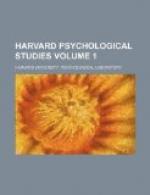TABLE LXII.
Proportional. Single Beat. 2-Beat
Group. 4-Beat Group. 8-Beat Group.
M.V. 1.000
0.512 0.480 0.320
The persons taking part in the investigation were next required to make a series of reactions composed of unit groups of two beats, in each of which the first member received accentuation, a simple trochaic rhythm. In this type the relation of intra-group to inter-group interval remains unchanged. In all subjects but one the mean variation of the first interval exceeds that of the second in the average ratio 1.722:1.000. The amount of difference is less than in the preceding type of reaction. In the former there is presented not an intensively uniform series, but an irregularly rhythmical grouping of intensities, in dependence on the well-defined parallel types of temporal differentiation; in the latter such intensive differentiation is fundamental and constant in its form. Assuming the character of the second interval to remain unchanged, there is in the intensive fixity of the initial accented element, on the one hand, and the alternate assertion of the impulse to accentuation and repression of it in the attempt to preserve uniformity, on the other, an occasion for the difference in the relation of the mean variation of this interval to that of the following in the two cases. It is to be expected that there should be less irregularity in a series of reactions each of which represents an attempt to produce a definite and constant rhythmical accent, than in a series in which such an accent is spasmodically given and repressed.
For a like reason, the difference in value between the mean variations of the elementary interval and the unit group should be less in the case of the positive rhythm form than in that of a series which combines a definite temporal segregation with an attempt to maintain intensive uniformity. The mean variation of the interval is still of greater value than that of the unit group, but stands to it in the reduced ratio 1.000:0.969.
The relations of higher groups present
certain departures from the preceding type. In
three cases out of five the unit has a greater
> .
fixity than its immediate compound ( | q. q; q q |),
with an average
\_______/
ratio of 0.969:1.072. The original relation,
however, is reestablished in the case of the next
higher multiple, the eight-beat group, the whole series
of values, arranged on the basis of unity for the simple
interval, being as follows:




